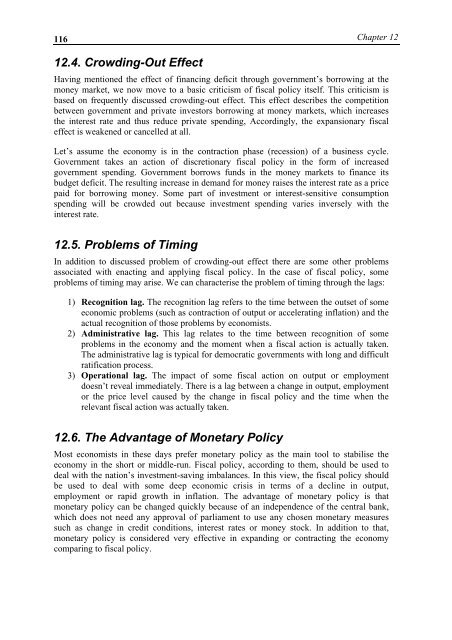MacroeconomicsI_working_version (1)
Create successful ePaper yourself
Turn your PDF publications into a flip-book with our unique Google optimized e-Paper software.
116<br />
Chapter 12<br />
12.4. Crowding-Out Effect<br />
Having mentioned the effect of financing deficit through government’s borrowing at the<br />
money market, we now move to a basic criticism of fiscal policy itself. This criticism is<br />
based on frequently discussed crowding-out effect. This effect describes the competition<br />
between government and private investors borrowing at money markets, which increases<br />
the interest rate and thus reduce private spending, Accordingly, the expansionary fiscal<br />
effect is weakened or cancelled at all.<br />
Let’s assume the economy is in the contraction phase (recession) of a business cycle.<br />
Government takes an action of discretionary fiscal policy in the form of increased<br />
government spending. Government borrows funds in the money markets to finance its<br />
budget deficit. The resulting increase in demand for money raises the interest rate as a price<br />
paid for borrowing money. Some part of investment or interest-sensitive consumption<br />
spending will be crowded out because investment spending varies inversely with the<br />
interest rate.<br />
12.5. Problems of Timing<br />
In addition to discussed problem of crowding-out effect there are some other problems<br />
associated with enacting and applying fiscal policy. In the case of fiscal policy, some<br />
problems of timing may arise. We can characterise the problem of timing through the lags:<br />
1) Recognition lag. The recognition lag refers to the time between the outset of some<br />
economic problems (such as contraction of output or accelerating inflation) and the<br />
actual recognition of those problems by economists.<br />
2) Administrative lag. This lag relates to the time between recognition of some<br />
problems in the economy and the moment when a fiscal action is actually taken.<br />
The administrative lag is typical for democratic governments with long and difficult<br />
ratification process.<br />
3) Operational lag. The impact of some fiscal action on output or employment<br />
doesn’t reveal immediately. There is a lag between a change in output, employment<br />
or the price level caused by the change in fiscal policy and the time when the<br />
relevant fiscal action was actually taken.<br />
12.6. The Advantage of Monetary Policy<br />
Most economists in these days prefer monetary policy as the main tool to stabilise the<br />
economy in the short or middle-run. Fiscal policy, according to them, should be used to<br />
deal with the nation’s investment-saving imbalances. In this view, the fiscal policy should<br />
be used to deal with some deep economic crisis in terms of a decline in output,<br />
employment or rapid growth in inflation. The advantage of monetary policy is that<br />
monetary policy can be changed quickly because of an independence of the central bank,<br />
which does not need any approval of parliament to use any chosen monetary measures<br />
such as change in credit conditions, interest rates or money stock. In addition to that,<br />
monetary policy is considered very effective in expanding or contracting the economy<br />
comparing to fiscal policy.




